Exploring the Coordination Mechanism for Public Housing Supply with Urban Growth Management: A Case Study of Chongqing, China
Abstract
:1. Introduction
2. Literature Review
2.1. Public Housing Supply
2.2. Urban Growth Management
3. Methods and Data Collection
3.1. Case Area
3.2. Data Collection
4. System Dynamics Model for Urban Development
4.1. Conceptual Model
4.2. Feedbacks in the Model
4.2.1. Feedbacks in the Population Subsystem and Economy Subsystem
4.2.2. Feedbacks in the Housing Subsystem
4.3. Flow Diagram and Variables
5. Scenario Simulation
5.1. The Central Area of Chongqing
5.2. Results
5.3. Policy Simulation Experiment to Promote Urban Inclusive Growth
5.3.1. Population Control Policy Simulation
5.3.2. Public Housing Supply Policy Simulation
5.3.3. Combination Simulation
6. Discussion
7. Conclusions
Author Contributions
Funding
Conflicts of Interest
Appendix A
| Subsystem | Variable | Variable Abbreviation |
|---|---|---|
| Population subsystem | Population | POP |
| Net Births | NB | |
| Net Birth Rate | NBR | |
| Population Outmigration | PO | |
| Population Outmigration Rate | POR | |
| Population Immigration | PI | |
| Population Immigration Rate | PIR | |
| Labor Participation Fraction | LPF | |
| Economy subsystem | Business Structures | BS |
| Business Outmigration | BO | |
| Business Outmigration Rate | BOR | |
| Business Immigration | BI | |
| Business Immigration Rate | BIR | |
| Labor Force Availability | LFA | |
| Jobs | JOB | |
| Jobs per Business Structure | JBS | |
| Business Structure Land | BSL | |
| Land per Business Structure | LBS | |
| Land Availability on Business Construction | LABC | |
| Housing subsystem | Housing | HOU |
| Public Housing | PH | |
| Public Housing Construction | PHC | |
| Public Housing Construction Rate | PHCR | |
| Land Supply Intensifier | LSI | |
| Goal | GOA | |
| Coverage Rate | CR | |
| Gap | GAP | |
| Commodity Housing | CH | |
| Commodity Housing Demolition | CHD | |
| Commodity Housing Demolition Rate | CHDR | |
| Commodity Housing Construction | CHC | |
| Commodity Housing Construction Rate | CHCR | |
| Land Availability on Commodity Housing Construction | LACC | |
| Land Availability on Housing Construction | LAHC | |
| Land Availability on Public Housing Construction | LAPC | |
| Attractiveness on Housing Construction | AOHC | |
| Housing Land | HL | |
| Land per House | LH | |
| Linkage subsystem | House per Person | HP |
| Jobs to Labor Force Ratio | JLFR | |
| Land Fraction Occupied | LFO | |
| Construction Land | CL | |
| Housing Availability on Immigration | HAI | |
| Job Availability on Immigration | JAI | |
| Urban management strategy | Urban Population Control Policies | UPCP |
| Public Housing Supply Policies | PHSP |
References
- Huang, L.; Yan, L.; Wu, J. Assessing urban sustainability of Chinese megacities: 35 years after the economic reform and open-door policy. Landsc. Urban Plan. 2016, 145, 57–70. [Google Scholar] [CrossRef]
- Ye, Z.; Qian, L.; Na, Z. Financial Development, Urbanization, and Urban-Rural Income Disparity: Evidence Based on Chinese Provincial Data. Mod. Econ. 2018, 9, 31–60. [Google Scholar] [CrossRef] [Green Version]
- Cohen, B. Urban Growth in Developing Countries: A Review of Current Trends and a Caution Regarding Existing Forecasts. World Dev. 2004, 32, 23–51. [Google Scholar] [CrossRef]
- Ding, C.; Duan, X.; Niu, Y. Megacities in the World: Growth, Challenges and Appreciation. Urban Plan. Int. 2015, 30, 1–13. [Google Scholar]
- Roy, A. Slumdog Cities: Rethinking Subaltern Urbanism. Int. J. Urban Reg. Res. 2011, 35, 223–238. [Google Scholar] [CrossRef]
- Liu, X.; Chen, Z.; Lu, M. Social integration and economic growth: Endogenous policy changes of urbanization and urban development. J. World Econ. 2010, 6, 60–80. [Google Scholar]
- Li, Y.; Wang, R. Urban inclusiveness and the social inclusion of internal migrants in China. China Popul. Resour. Environ. 2017, 27, 146–154. [Google Scholar]
- Wang, W.; Wu, Y.Z.; Sloan, M. A framework & dynamic model for reform of residential land supply policy in urban China. Habitat Int. 2018, 82, 28–37. [Google Scholar]
- Joint research group of the development research center of the State Council and the World Bank. China: Toward an efficient, inclusive and sustainable urbanization. Manag. World 2014, 4, 5–41. [Google Scholar]
- Zou, G.; Chau, K. Determinants and sustainability of house prices: The case of Shanghai, China. Sustainability 2015, 7, 4524–4548. [Google Scholar] [CrossRef] [Green Version]
- Gan, X.; Zuo, J.; Chang, R.; Li, D.; Zillante, G. Exploring the determinants of migrant workers’ housing tenure choice towards public rental housing: A case study in Chongqing, China. Habitat Int. 2016, 58, 118–126. [Google Scholar] [CrossRef]
- Lv, P.; Chen, H. On the policy orientation based on the relationship between commercial housing and affordable housing. Soc. Sci. Beijing 2014, 11, 61–67. [Google Scholar]
- Yu, X.; Zeng, H.; Ren, T. Crowd-out effect of government-subsidized housing to commercial housing market: Theoretical and empirical analysis. Acad. Mon. 2015, 47, 57–65. [Google Scholar]
- Mao, F.; Wang, J. Can indemnificatory housing promote population flow?—A gravity model analysis based on the inter-provincial population flow. East China Econ. Manag. 2016, 30, 86–95. [Google Scholar]
- Wu, Y.; Wang, W. Research on the coordination mechanism of affordable housing and urban economic growth. J. Hehai Univ. 2016, 18, 27–33. [Google Scholar]
- Wetzstein, S. The global urban housing affordability crisis. Urban Stud. 2017, 54, 3159–3177. [Google Scholar] [CrossRef]
- Driant, J. The Main Issues of Social Housing Policies in Europe and in France. Urban Plan. Int. 2009, 4, 22–27. [Google Scholar]
- Moore, R. Slow Burn City: London in the Twenty-First Century; Picador: London, UK, 2016. [Google Scholar]
- Blokland, T. “You got to remember you live in public housing”: Place-Making in an American housing project. Hous. Theory Soc. 2008, 25, 31–46. [Google Scholar] [CrossRef]
- Madden, D.; Marcuse, P. Defense of Housing; Verso: London, UK; New York, NY, USA, 2016. [Google Scholar]
- Rosen, K.; Madelyn, R. Increasing homeownership in urban China: Notes on the problem of affordable. Hous. Stud. 2000, 15, 77–89. [Google Scholar] [CrossRef]
- Hui, C.M.; Leung, Y.P.; Yu, K.H. The impact of different land-supplying channels on the supply of housing. Land Use Policy 2014, 39, 244–253. [Google Scholar] [CrossRef]
- Zou, Y. Contradictions in China’s affordable housing policy: Goals vs. structure. Habitat Int. 2014, 41, 8–16. [Google Scholar] [CrossRef]
- Wong, G. Vertical cities as a solution for land scarcity: The tallest public housing development in Singapore. Urban Des. Int. 2004, 9, 17–30. [Google Scholar] [CrossRef]
- Zheng, S.; Zhang, Y.; Zhang, S.; Long, Y.; Du, L. The Evaluation Method of Affordable Housing Site Selection Based on the Trade-off between Social Benefit and the Opportunity Cost of Land: A Quantitative Analysis Based on the Differences in Preferences of Residential Location Choice between High-income and Low-income Residents. Manag. Rev. 2016, 8, 3–11. [Google Scholar]
- Shamsuddin, S.; Vale, L.J. Lease it or lose it? The implications of New York’s Land Lease Initiative for public housing preservation. Urban Stud. 2017, 54, 137–157. [Google Scholar] [CrossRef]
- Ding, C. Growth of World Megacities: Trend, Challenge, Growth Policy and Effectiveness; China Architecture & Building Press: Beijing, China, 2015. [Google Scholar]
- Kuznets, S. Economic growth and income inequality. Am. Econ. Rev. 1955, 45, 1–28. [Google Scholar]
- Alesina, A.; Perotti, R. Income distribution, political instability, and investment. Eur. Econ. Rev. 1996, 40, 1203–1228. [Google Scholar] [CrossRef] [Green Version]
- Benner, C.; Pastor, M. Just Growth: Inclusion and Prosperity in America’s Metropolitan Regions; Routledge: Oxon, UK; New York, NY, USA, 2012. [Google Scholar]
- Lu, M. Great State Needs Bigger City; Shanghai People’s Publishing House: Shanghai, China, 2016. [Google Scholar]
- Kemeny, J. From Public Housing to the Social Market: Rental Policy Strategies in Comparative Perspective; Routledge: London, UK, 1995. [Google Scholar]
- Barr, N. The Economics of the Welfare State; Stanford University Press: Redwood, CA, USA, 1998. [Google Scholar]
- Dipasquale, D.; Wheaton, W. Urban Economics and Real Estate Markets; Englewood Cliffs: Prentice-Hall, NJ, USA, 1996. [Google Scholar]
- Glaeser, E.L.; Gyourko, J.; Saks, R.E. Urban growth and housing supply. J. Political Econ. 2006, 6, 71–89. [Google Scholar] [CrossRef] [Green Version]
- Fu, Y.; Zheng, S.; Liu, H. Population Growth across Chinese Cities: Demand Shocks, Housing Supply Elasticity and Supply Shifts. Available online: https://ssrn.com/abstract=1153022 or http://dx.doi.org/10.2139/ssrn.1153022 (accessed on 1 July 2008).
- Long, F.; Guo, M. Research on the impact of land supply on urban growth in China. Urban Dev. Stud. 2009, 6, 83–87. [Google Scholar]
- Zheng, S.; Liao, J.; Ren, R.; Cao, Y. Housing policy for migrant workers and economic growth. Econ. Res. J. 2011, 2, 73–86. [Google Scholar]
- Wang, X. A Study on the Impact Assessment of Public Housing Residential District on Urban Social Space. Ph.D. Thesis, Southeast University, Dhaka, Bangladesh, 2016. [Google Scholar]
- Tusting, L.S.; Bisanzio, D.; Alabaster, G.; Cameron, E.; Cibulskis, R.; Davies, M.; Flaxman, S.; Gibson, H.S.; Knudsen, J.; Mbogo, C.; et al. Mapping changes in housing in sub-Saharan Africa from 2000 to 2015. Nature 2019, 568, 391–394. [Google Scholar] [CrossRef]
- Berry, M. Why is it important to boost the supply of affordable housing in Australia—And how can we do it? Urban Policy Res. 2003, 21, 413–435. [Google Scholar] [CrossRef]
- Quigley, J.M.; Raphael, S. Is Housing Unaffordable? Why Isn’t It More Affordable? J. Econ. Perspect. 2004, 18, 191–214. [Google Scholar] [CrossRef] [Green Version]
- Tao, L.; Hui, E.C.M.; Wong, F.K.W.; Chen, T. Housing choices of migrant workers in China: Beyond the Hukou perspective. Habitat Int. 2015, 49, 474–483. [Google Scholar] [CrossRef]
- Bloom, N.D.; Umbach, F.; Vale, L.J. Public Housing Myths: Perception, Reality, and Social Policy; Ithaca & Cornell University Press: London, UK, 2015. [Google Scholar]
- Popkin, S.J. No Simple Solutions: Transforming Public Housing in Chicago; Rowman & Littlefield: Lanham, MD, USA, 2016. [Google Scholar]
- Aliprantis, D.; Hartley, D. Blowing it up and knocking it down: The local and city-wide effects of demolishing high concentration public housing on crime. J. Urban Econ. 2015, 88, 67–81. [Google Scholar] [CrossRef]
- Forrester, J. Urban Dynamics; MIT Press: Cambridge, MA, USA, 1969. [Google Scholar]
- Tsai, C. Housing affordability, self-occupancy housing demand and housing price dynamics. Habitat Int. 2013, 40, 73–81. [Google Scholar] [CrossRef]
- Zhao, P. Informal Suburbanization in Beijing: An Investigation of Informal Gated Communities on the Urban Fringe. Habitat Int. 2018, 77, 130–142. [Google Scholar] [CrossRef]
- Woolston, C. A home on a budget. Nature 2017, 547, 247–249. [Google Scholar] [CrossRef] [Green Version]
- Batty, M. The New Science of Cities; MIT Press: Cambridge, MA, USA, 2013. [Google Scholar]
- Xu, H.; Zhou, Y. Public housing provision and housing vacancies in Japan. J. Jpn. Int. Econ. 2019, 53, 1–14. [Google Scholar] [CrossRef]
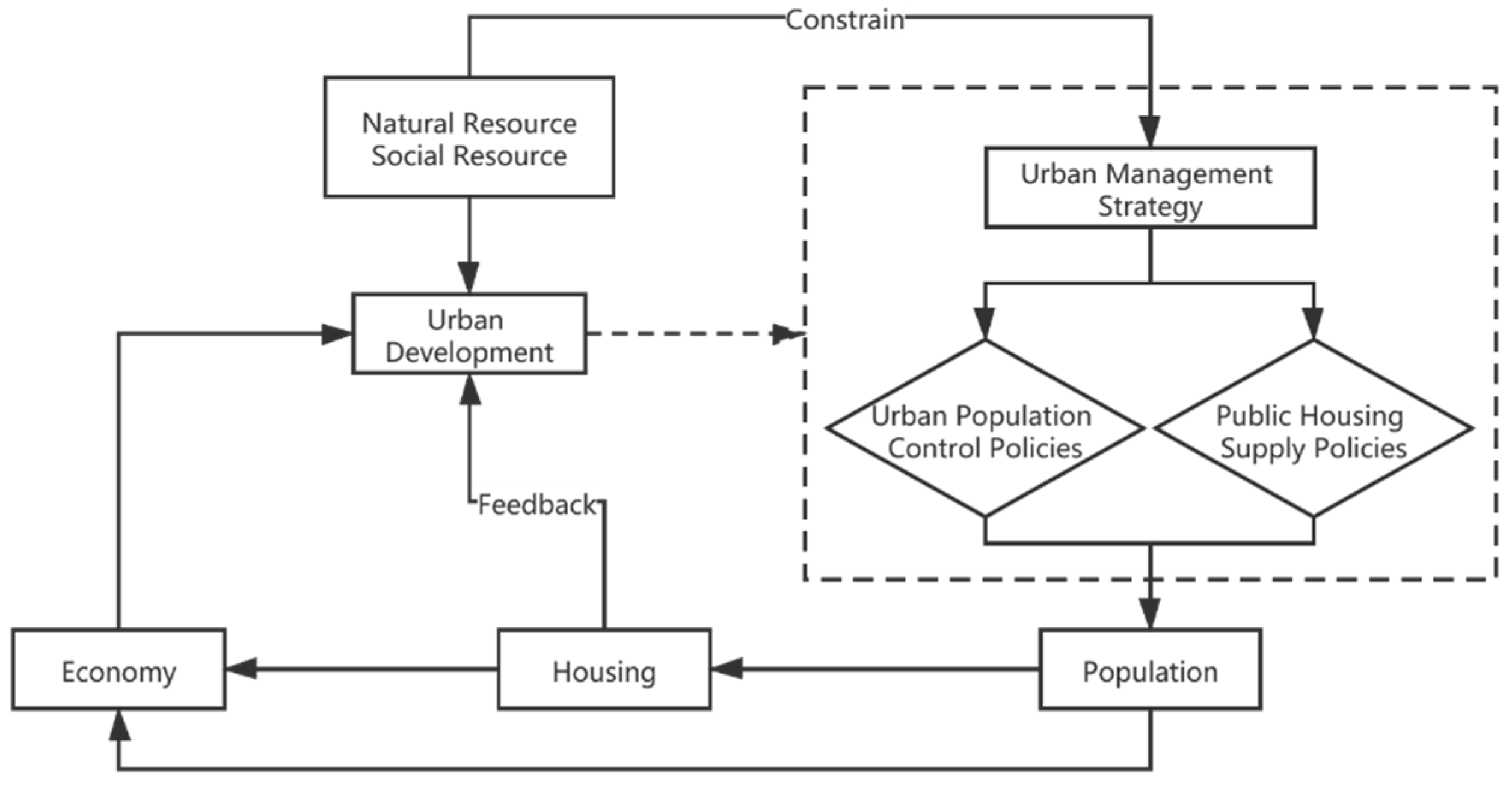
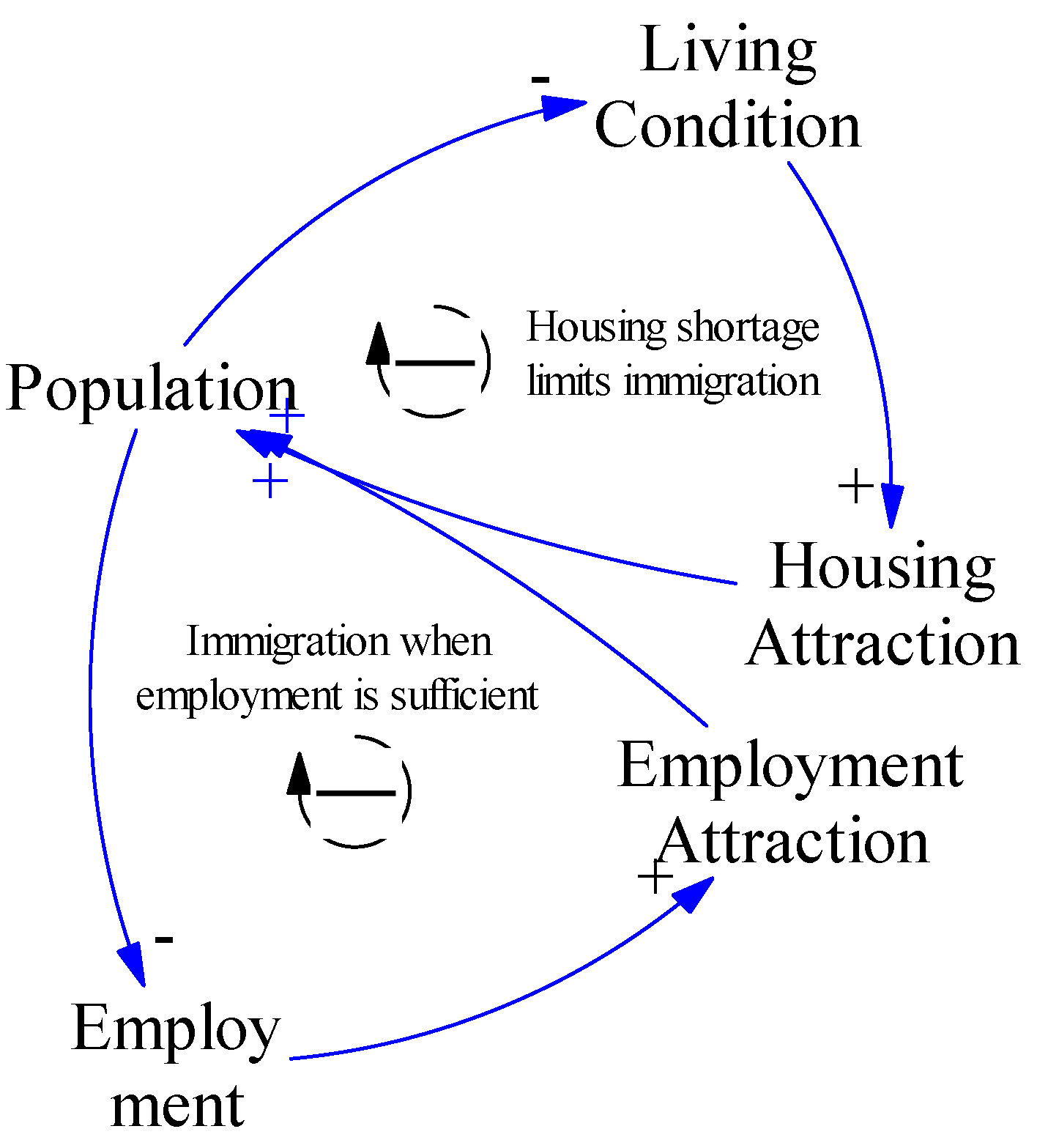
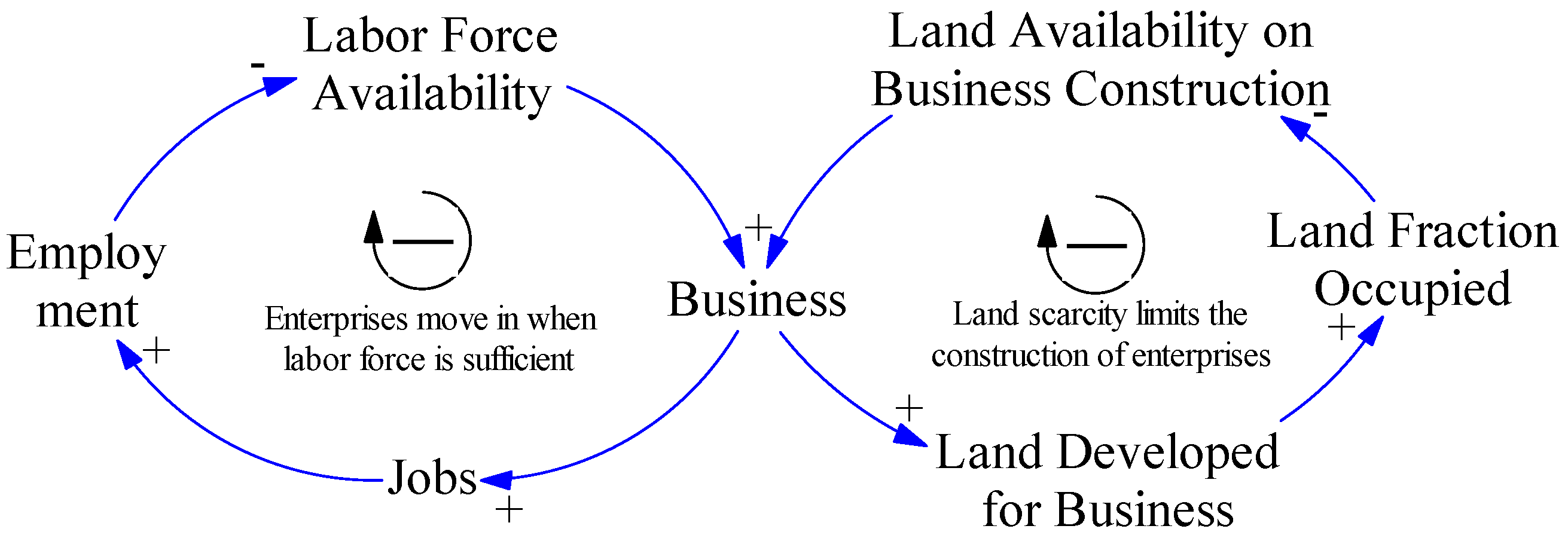
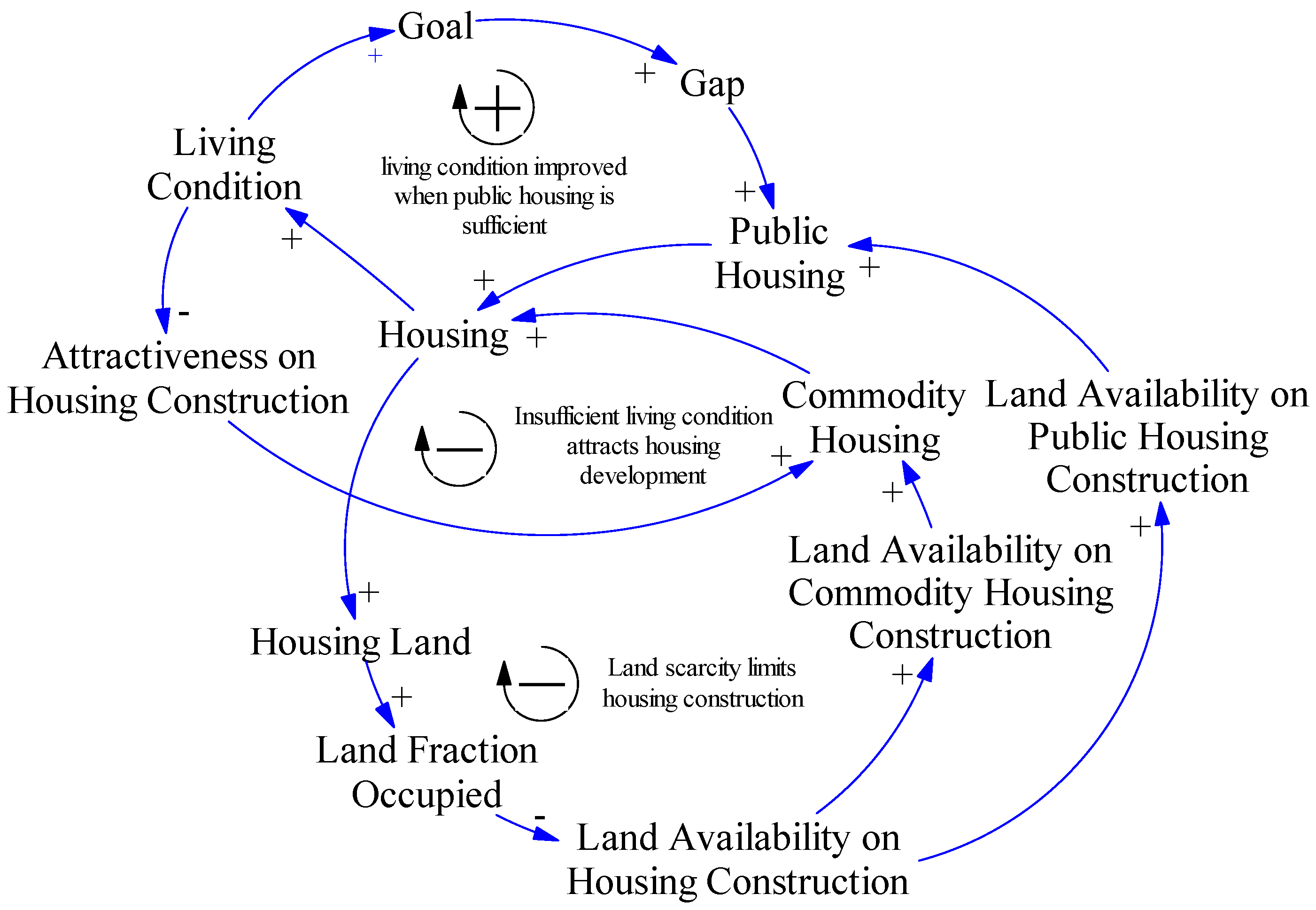
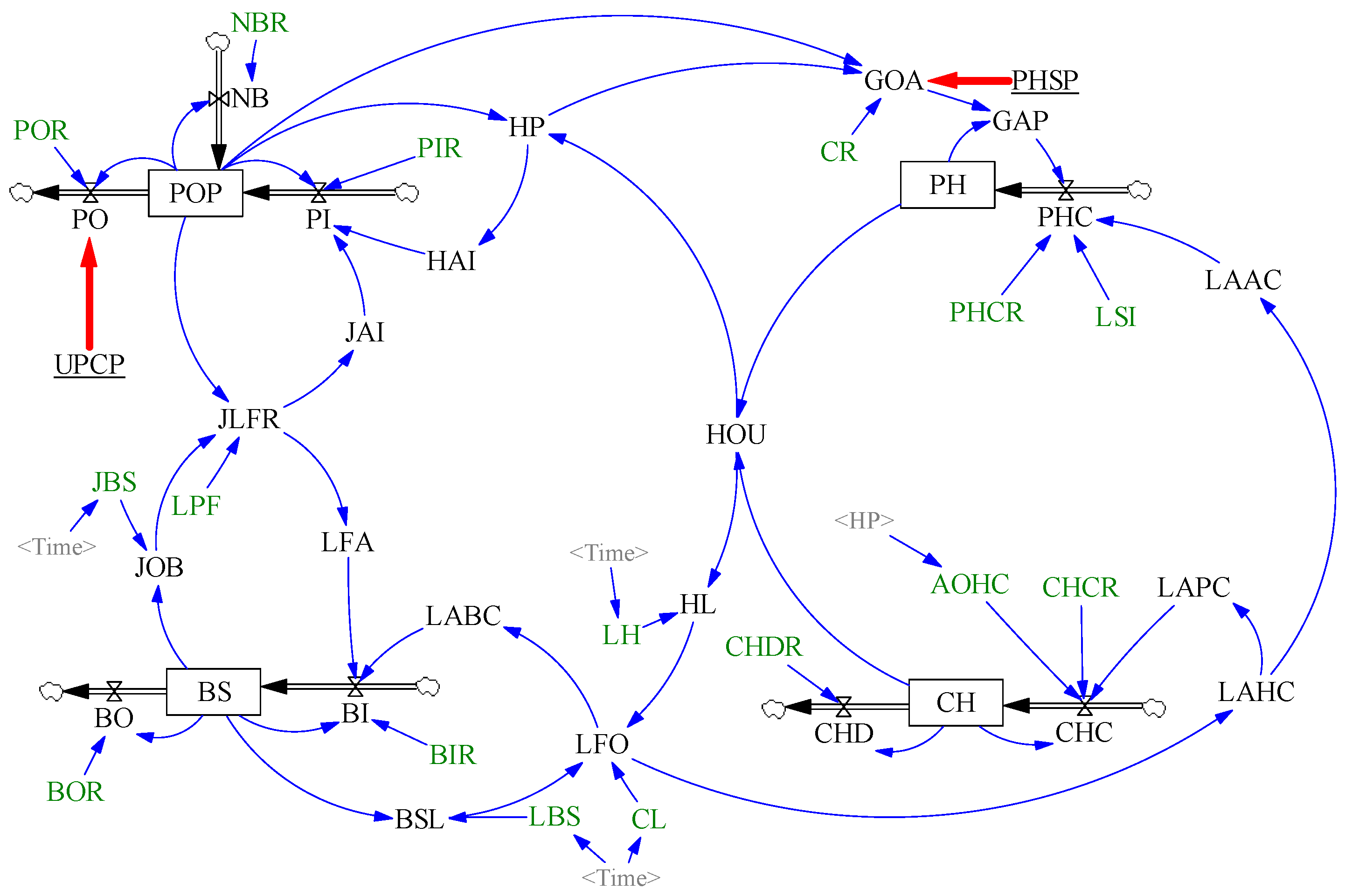

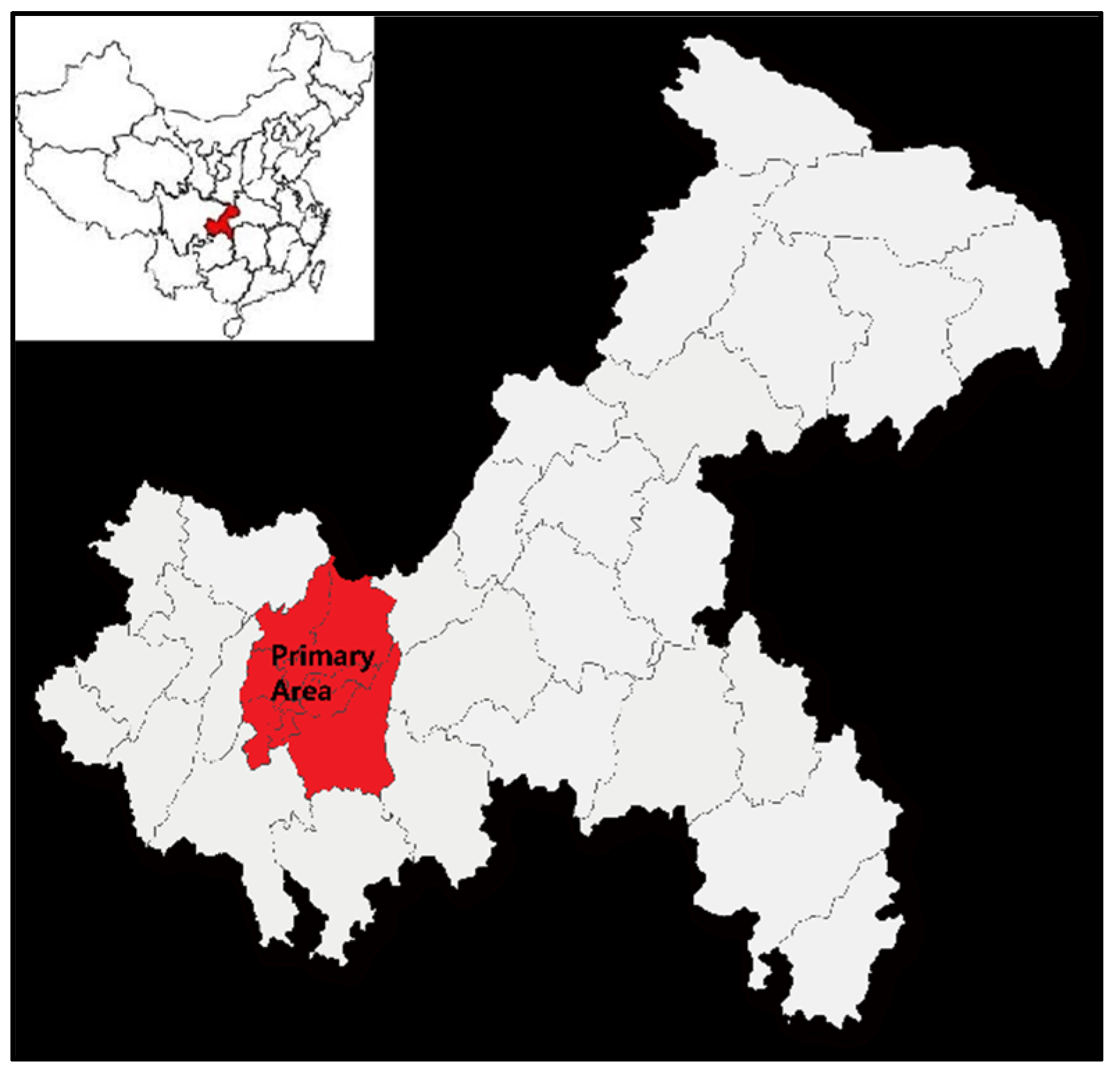
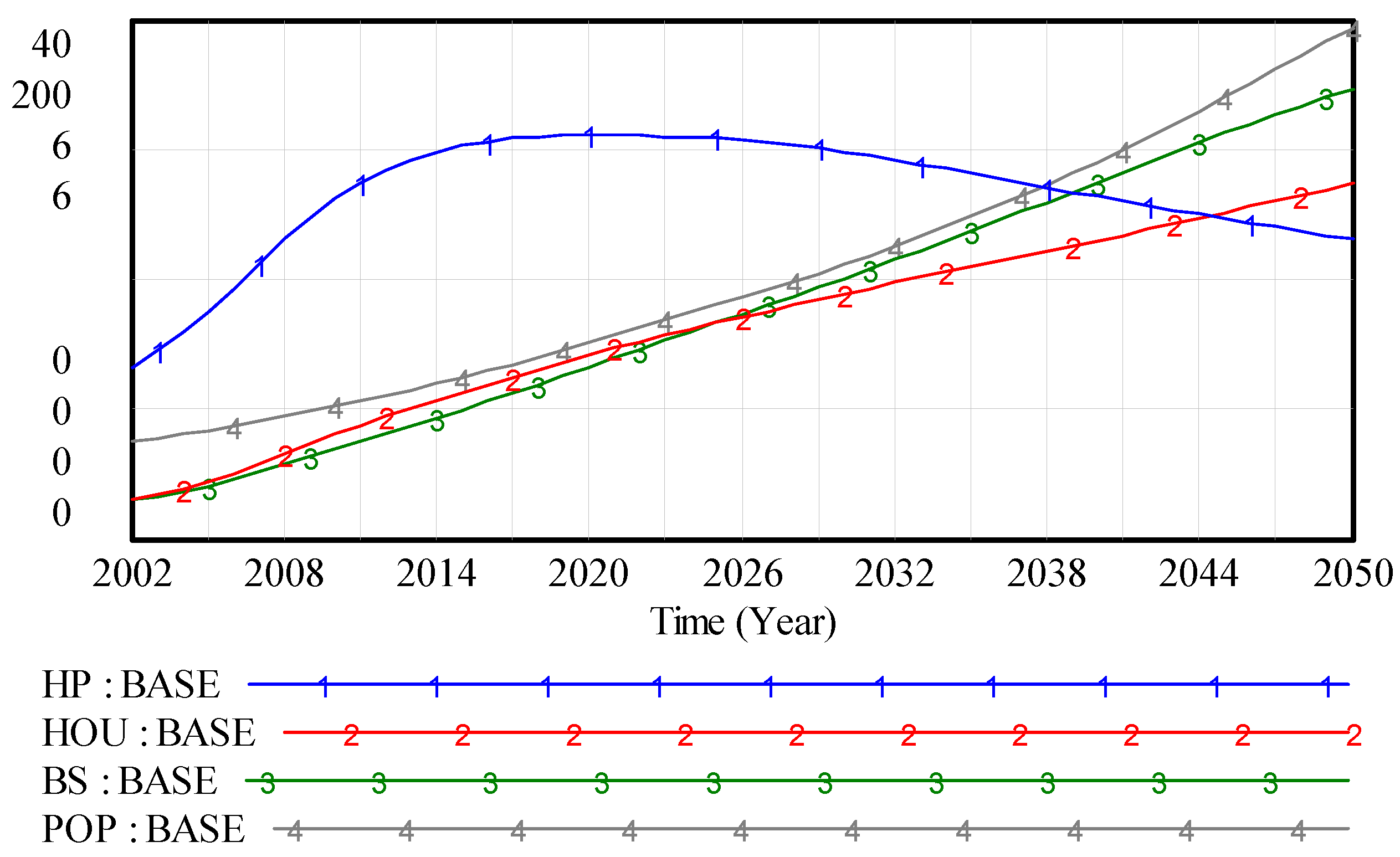
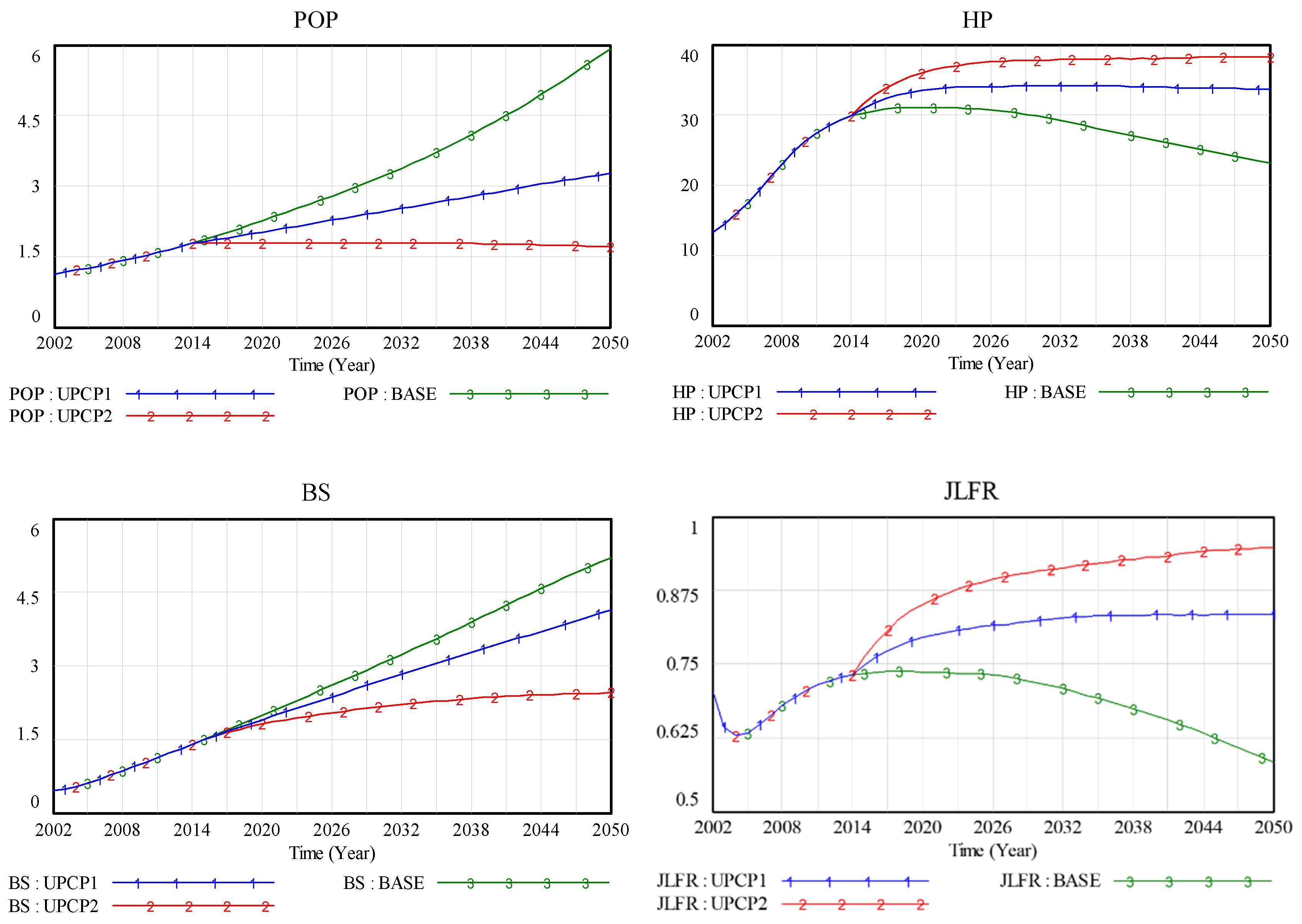
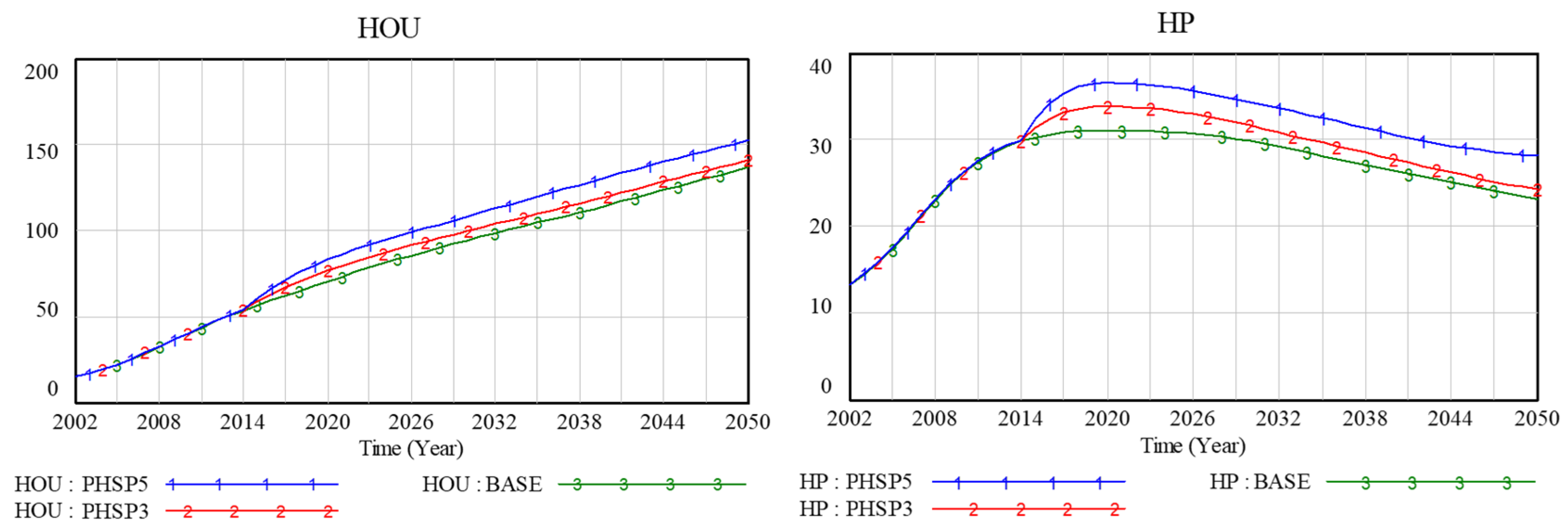

| Chongqing City | China | ||||
|---|---|---|---|---|---|
| 2000 | 2005 | 2010 | 2015 | 2015 | |
| GDP per capita/yuan | 6274 | 10,845 | 27,598 | 52,322 | 50,251 |
| Proportion of three industries/% | 16:42:42 | 13:45:42 | 8:45:47 | 7:45:48 | 9:41:50 |
| Proportion of employment in three industries/% | — | — | — | 31:28:41 | 28:30:42 |
| Proportion of employment between urban and rural/% | 32:68 | 40:60 | 48:52 | 58:42 | 52:48 |
| Registered unemployment rate/% | 3.5 | 4.12 | 3.9 | 3.6 | 4.1 |
| Proportion of labor force(%) | 67.8 | 68.4 | 71.5 | 71.3 | 73.0 |
| Disposable income of urban residents/yuan | 6176 | 10,244 | 17,532 | 27,239 | 31,195 |
| Disposable expenditure of urban residents/yuan | — | — | 13,335.02 | 19,742.29 | 21,392.36 |
| Urbanization/% | 35.6 | 45.2 | 53 | 60.9 | 56.1 |
| Urban Development Stages | Population Number | Housing Number | Housing per Person |
|---|---|---|---|
| Growth | ↗ | ↗ | ↗ |
| Balance | → | → | → |
| Crisis | ↗ | → | ↘ |
| Decline | ↘ | → | ↗ |
© 2020 by the authors. Licensee MDPI, Basel, Switzerland. This article is an open access article distributed under the terms and conditions of the Creative Commons Attribution (CC BY) license (http://creativecommons.org/licenses/by/4.0/).
Share and Cite
Wang, W.; Wu, Y. Exploring the Coordination Mechanism for Public Housing Supply with Urban Growth Management: A Case Study of Chongqing, China. Sustainability 2020, 12, 4047. https://doi.org/10.3390/su12104047
Wang W, Wu Y. Exploring the Coordination Mechanism for Public Housing Supply with Urban Growth Management: A Case Study of Chongqing, China. Sustainability. 2020; 12(10):4047. https://doi.org/10.3390/su12104047
Chicago/Turabian StyleWang, Wei, and Yuzhe Wu. 2020. "Exploring the Coordination Mechanism for Public Housing Supply with Urban Growth Management: A Case Study of Chongqing, China" Sustainability 12, no. 10: 4047. https://doi.org/10.3390/su12104047
APA StyleWang, W., & Wu, Y. (2020). Exploring the Coordination Mechanism for Public Housing Supply with Urban Growth Management: A Case Study of Chongqing, China. Sustainability, 12(10), 4047. https://doi.org/10.3390/su12104047





